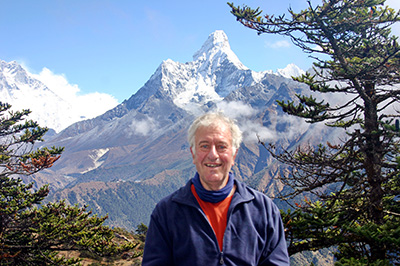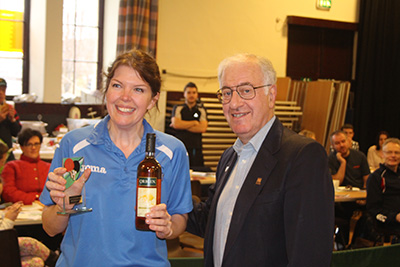Q&A – Roger Thomas
Roger Thomas has been a key figure within Murrayfield Table Tennis Club for several decades. He joined in the 1960s when a student at Edinburgh University and became a member of the club’s first team and a leading Edinburgh & District player. He’s also held significant administrative positions within the club, including secretary and Vice-President.
Since leaving the club, he has played a role in the rapid development of Haddington Table Tennis Club, though maintains his Murrayfield connection as a trustee of the club. The re-established Murrayfield Club Championship now bears his name – the winner receives the Roger Thomas Quiach. Roger has also been a prominent umpire within Scottish table tennis, often acting as a tournament referee and delivering umpire training courses. Roger worked for IBM for over 20-years before moving into business coaching work. In this interview, Roger reflects on his time as a player, umpiring, and the development of Murrayfield TTC and Scottish table tennis more generally.
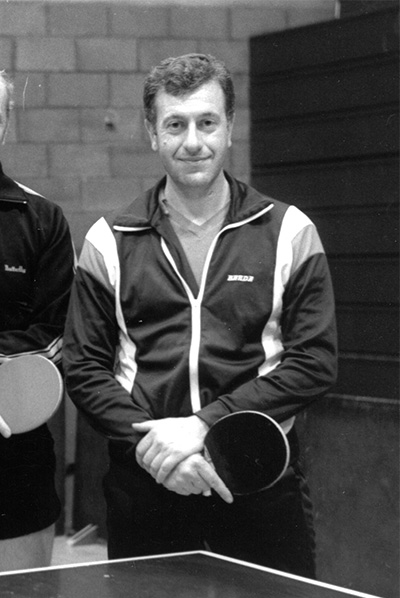
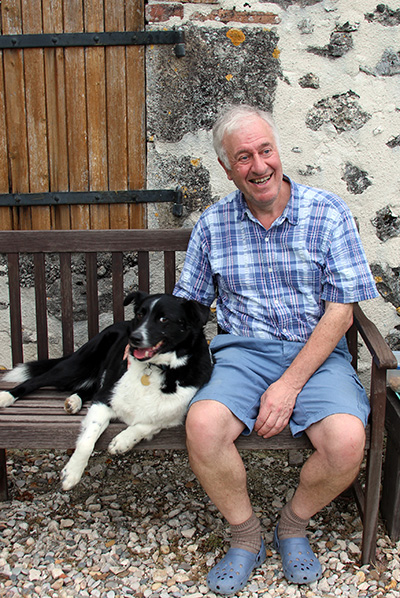
Q&A
▸ Where did you grow up and how did you first get into table tennis?
▹ I grew up in a semi-rural suburb of Stoke-on-Trent in the English midlands. I started playing TT at a youth club as a teenager. When I came to university in Edinburgh in autumn 1965 I was persuaded to join the university TT club during the “Fresher’s Week” when every club and society was recruiting new arrivals. The University had three teams in the then Edinburgh & District TT League and I joined the third team playing in division 5. I well recall my very first match, against Alan McKean of North Merchiston, who had spin serves the likes of which I’d not previously encountered and I really struggled to return them and lost quite easily. I was determined not to suffer again and quickly learned to cope and never lost to Alan again!
▸ How would you describe your style of play and how did it developed over the years?
▹ My style now is much as it was when I started, though for different reasons. Then I was what I’d describe as a “container and counter-hitter” my idea being to prevent the opponent playing their preferred style and taking advantage of any loose shots. These days I play much the same mainly because I’m not as quick on my feet as I used to be! In between my early play and now (some 50 years) I developed quite an all-round game including a chop defence and a reasonable backhand drive and a looped forehand. Which still, on occasion, come in useful.
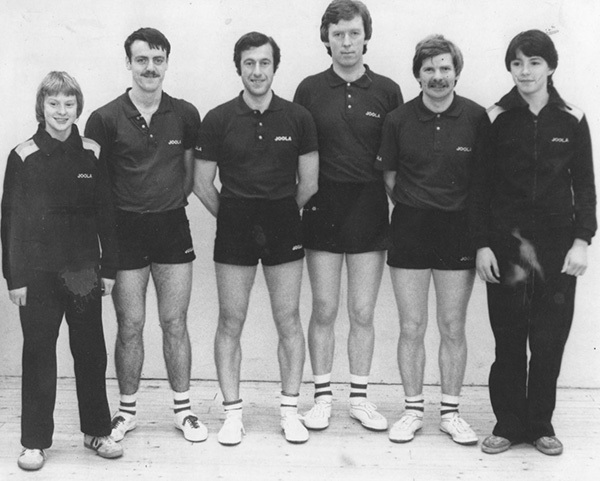
▸ Who influenced you style of play? Coaches are clubmates?
▹ There were two league players whom I both admired and lost to frequently and hence was determined to beat – and did, eventually. One was the best player in division 2 (where I played my second season for University) Alan Nicholls, who played for the Police team and was a very good defender back from the table and also had an occasional effective forehand (not unlike Russell Frith at my present club, Haddington). I tried to copy Alan’s defensive style as part of my all-round game. The other was Bert Kerr who also had the sort of all-round game that appealed to me. By the time (early 1970s) I was playing against Bert I was in the first division and playing for Murrayfield after graduating. I beat Bert only twice (I can visualise the first time when my loop was working particularly well – it needed to – and I won match point with a great backhand that wrong-footed Bert.) It’s probably fair to say that at the time Bert was past his peak and I was at mine.
The club mate whom I most enjoyed playing with was Dave Fisher at University. We formed an effective doubles pair (though doubles didn’t feature in the Edinburgh League matches in those days; they did in the inter-university matches). I still really enjoy doubles play as it allows two different styles to complement each other.
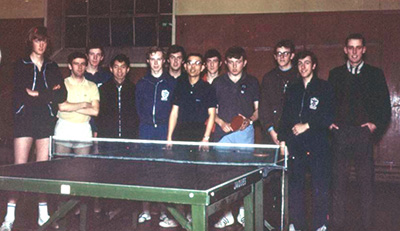
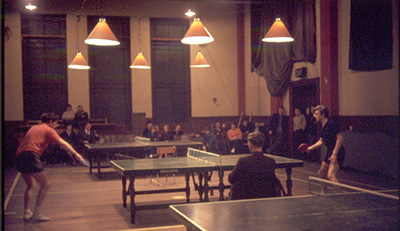
Allan Street tournament – 1969
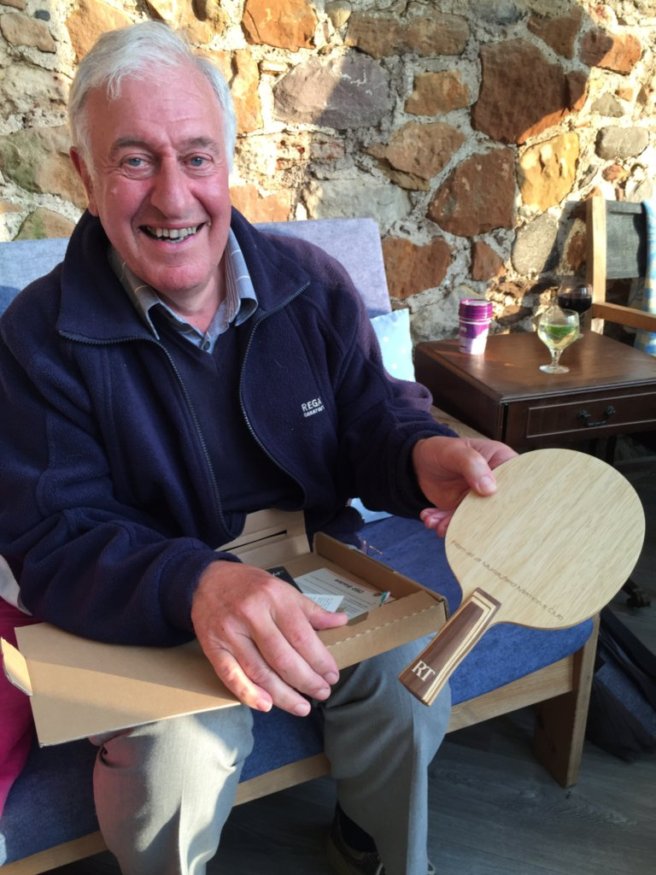
▸ What equipment did you use in your early days and did that change much over the years? [how’s the personalised bat?]
▹ My first bat was a Slazenger with green pimples but in my first season at Edinburgh I upgraded to a Stiga Erlich with blue reverse pimples. Over the years I’ve pretty much stayed with the same style, A Stiga “allround” blade and Butterfly “Sriver” reverse pimple rubber – now, of course, red and black. My current bat is a custom made recreation of Stiga allround blade (delightfully inscribed “From all at Murrayfield Memorial Club” – a present when, after 47 years, I left the club to play for my local club of which I’m also Chairman). I’ve not really tried much variation in bats or rubbers, though I have recently been advised to try the “old man’s” short pimples.
▸ How did you first get involved with Murrayfield? Was it while you were university or afterwards?
▹ I first encountered Murrayfield when playing against their then first team in division 2 in 1967,68, &69. I recall the team included Dave Hunter, Ronnie Stewart, and John Cowan. In the 1966-67 season, my first in our first team, we (Dave Fisher, Allan Turnbull and me) just avoided relegation from Division 2 then in 1967/68 we just failed to be promoted and in my final year, together with Murrayfield 1, we were promoted to division 1. Of course I then left the university team on graduation and I was invited to play for the team that had been promoted with us, Murrayfield. So I joined and played for some years with Dave Hunter and Ronnie Stewart.
▸ Who were the significant figures in the club when you first joined?
▹ The club President was Mr Terras who had been involved from the earliest days. He was quite elderly and wore very thick glasses. His daughter also played, but neither played in any team. George Smith was the Club Secretary for many years until he left to run the Tartan Club at Scottish Brewers. Our second team included John Cowan (a stolid defender, whom I umpired a few times when his games went to expedite rule play!).
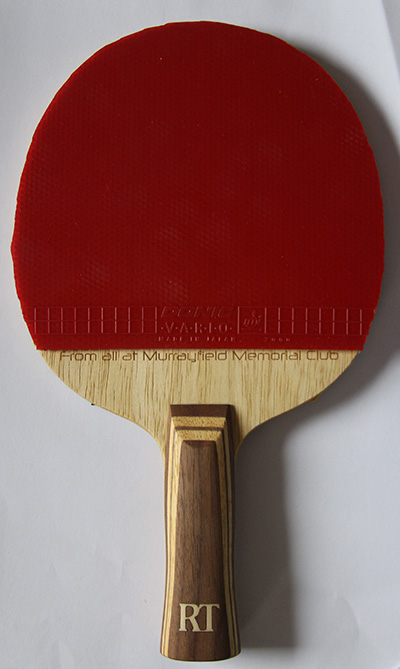
▸ You played at a time when the Murrayfield Memorial Club also contained other sections. Which other activities do remember going on at the club and did you get involved?
▹ Murrayfield Memorial Club comprised not only a TT section but also a model railway section (in the front room of the old building at Roseburn) and a chess section and a dominoes club.
▸ Who were the top players in your time in the higher echelons of the league?
▹ For many years after Ronnie Stewart gave up playing our first team comprised Dave Hunter, Ian Donald, and me. Ian had joined from the works team at United Glass Bottle Works. In the 1960s, 70s and 80s there were several teams in the League from local businesses/organisations, now, sadly, all such teams have atrophied. They included: The Police, The Civil Service, Scottish Brewers, The Post Office, Edinburgh Maccabi, The Prison (home games only!), Thistle Foundation (disabled players), MacTaggart Scott, Royal Mail, and Standard Life).
Apart from those early days when I played for MM 1, (and when, incidentally, we failed to win the Div 1 title one year-1976-77- when we drew on points with Gambit 1 but lost by just one game out of 150 or so on games difference – that was the season when I beat Bert) Murrayfield has had players who also represented Scotland, Pete Lugton, and Colin Robertson come to mind.
When I began playing in the Edinburgh league, the top players were, at Gambit: Bert Kerr, David Hogg, Tommy McMichael and occasionally Ian Barclay who was the Scotland No 1, Charlie Vesco (of YMCA) and later Eric Sutherland. I also recall John Hawkins, a tall policeman from the West of Scotland, who was an early and successful (Scottish No 2, I think) adopter of reverse pimple rubber and had a tremendous loop.

▸ What’s your proudest achievement in TT?
▹ There are quite a few (not surprisingly given my longevity in the game):
At University, getting TT recognised and properly funded by the University Athletic Club (the Sports governing body at the time). Also setting up (and captaining) the Scottish Universities team comprising players from all the universities. And being awarded a “Blue” by the university in my final season.
At Murrayfield leading the First Team for several years to success in the Handicap Cup and in the first division. Negotiating the sale of the old premises to Tom Farmer and setting up the initial relationship with the Church of the Good Shepherd to give us a new home.
Becoming an international umpire and promoting umpiring as a respected role with TT across the League.
Establishing Haddington TT Club as a thriving venture across East Lothian and winning awards locally and nationally for our efforts.
▸ What memories do you have of the old club premises on Corstorphine Road?
▹ Cold and dry rot and a large metal tea-pot. There was a single wood-burning stove in the big draughty hall (usually very little wood to burn)! Later replaced by a gas burning radiator that was not much better. But space to play was not a problem. Also the small kitchen where teams would repair after the match, usually for cups of tea and sandwiches (provided by the wives of the home team.) That after-match chat is, sadly, another aspect of league play that has disappeared.
The dry rot (which eventually persuaded us that the place was not sustainable) meant that we spent many a week-end repairing / renovating the building. Fortunately we had a few members who were tradesmen and could do much of that work.
I also remember when we would set up a stall at the front of the building to sell hamburgers / hot-dogs to passing rugby fans when there was an international at Murrayfield. That was in the days when regulations were rather laxer! It did help a little to raise funds for the Club. I remember one year when we also included a daffodil with every hamburger for the Welsh fans!
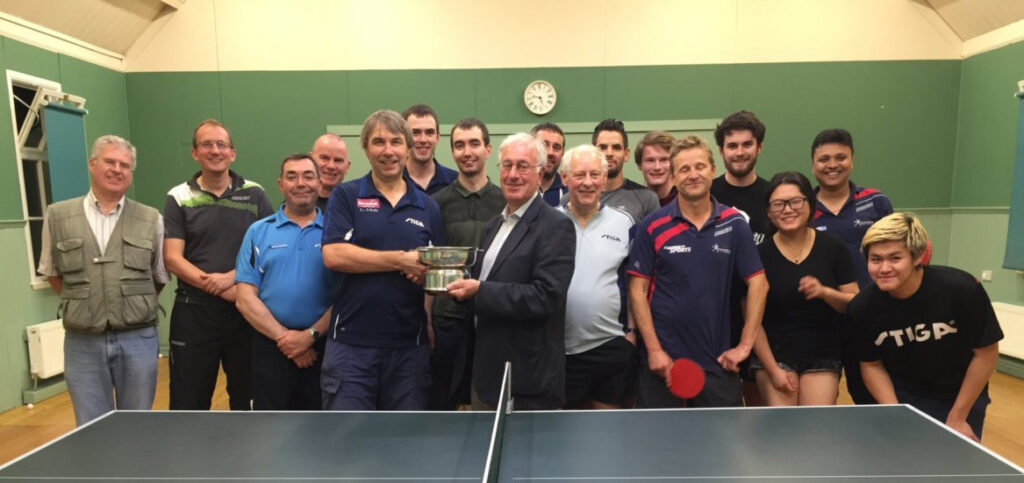
▸ You played a lot with Mike MacLaren in veterans’ events. What memories do you have of Mike?
▹ Mike and I played together for several season in the Murrayfield team as well as in veterans’ events, including winning the Scottish title. Mike was enthusiastic and knowledgeable about his TT (having played at county level in England) and, though not exactly the most orthodox, was an effective counter-attacking player.
▸ A lot of people seem to feel that the standard of the league (E&D / ELTTL) was a lot higher in the past – would you agree? If so, why?
▹ I’m not sure I’d agree that it was a lot higher. At times, yes, and at other times not so much. There were certainly several seasons when the top players in Scotland played in the league (Bert, Charlie, Eric, Terry Forker) nowadays there are / have been recently such as Craig Howieson, Colin Dalgleish, and Callum Morrison who have / surely will, be similarly rated.
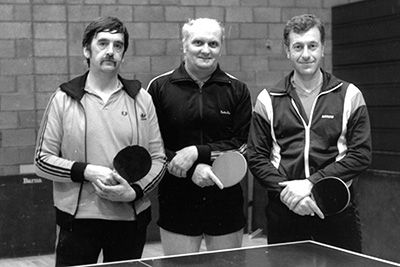
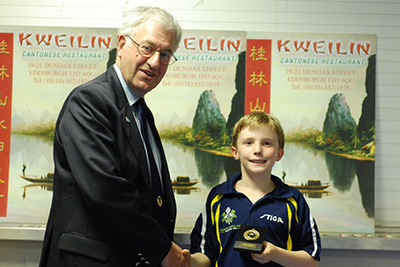
▸ You’ve been a qualified umpire for some time and have regularly acted as a tournament referee. Which rules need to be better enforced? Are there any rules you’d like to see changed?
▹ The thing I’d most like to see enforced/emphasised/just focussed on is that umpiring is a key part of the game and the umpire is in charge of the conduct of the game and has a responsibility to the players and the spectators. So just understanding that, and of course, actually knowing the rules would be a great improvement. That’s what I’ve been trying to improve with the umpiring clinics I’ve run for a few clubs (sadly most didn’t take up my offer.) Though I did run a successful series of exam-based and Q&A session for club representatives this last year, and convinced the league to make it a participating condition for clubs that they do have a qualified umpire in their teams.
The two aspects that I’d like to see done better by players are serving (just watch YouTube videos of international play to see how well players at that level always comply with the requirements of a legal serve) and over-the-top celebrations, which certainly in tournaments can be quite disturbing to neighbouring tables. On that latter point, I’d like to see rules tightened up on what is an unreasonable “cho!!!!!” or similar.
▸ You worked for IBM for many years and subsequently worked as a business coach. How easy did you find it to combine table tennis with work and family? Have they complemented each other?
▹ I worked for IBM for 25 years, mainly in Edinburgh and also for two years in London. It was OK combining TT with work when I was in Edinburgh as I could attend matches straight from the office after work. Though often I would be away in London or Manchester, I could usually either get back in time or change a fixture or get a stand-in. As to complementing family life – you’d better ask my wife! Certainly being away on business for days or weeks and then getting home only to head out for TT wasn’t ideal.
On the other hand, TT helped keep me fit and sane and not entirely focussed on work, and that was a good thing anyway for all of us. When I worked in London, I flew down on the first flight every Monday and back on the Friday evening and that wasn’t good for the family, nor for my TT, as I played only a few matches during those two years.
More recently, since 2000, I’ve been self-employed as one of two directors of a small UK-wide business coaching company and with the flexibility that provides I’ve been much more able to fit in family and TT life.
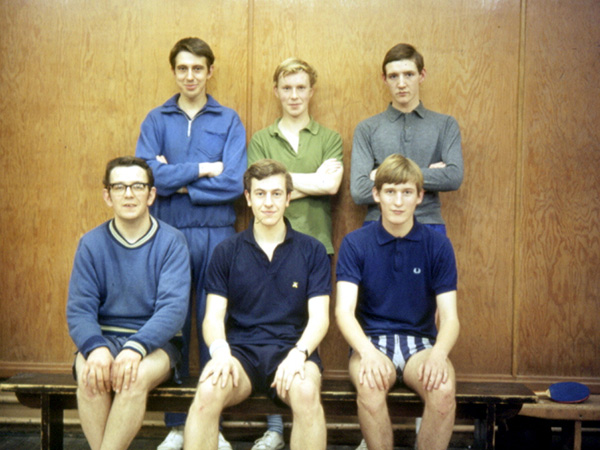
Back: Dave Fisher, Allan Turnbull, Ross Watson;
Front: Jim Alcock. Roger Thomas, Paul Cooper.
▸ How often did you play? Any these days? Have you played much since March and the Covid-19 lockdown?
▹ I still play twice every week, once in a league match (now back in Div. 2) and once coaching at my Haddington club. Though I’ve not played at all since March this year. Occasionally take out my bat and hold it and bounce a ball; withdrawal symptoms!
▸ Apart from table tennis, how do you spend your free time?
▹ Before this restricted period and had lots to keep me busy! I run the admin/finance/operations of our company – about a day a week. I enjoy gardening – it’s a good opportunity to think things through. I have a couple of classic cars and my son has also and we attend classic car events just a few times a year – including Le Mans Classique. I have a telescope in a special shed in the garden, as Astronomy has been my hobby since teenage years. And I read a lot – even more so this year, mainly non-fiction. And my wife and I go to our cottage in France for a couple of months each year (except 2020, sadly) where our French neighbours are wonderful friends. This year I’ve been having French conversation lessons with a French lady in Aberlady.
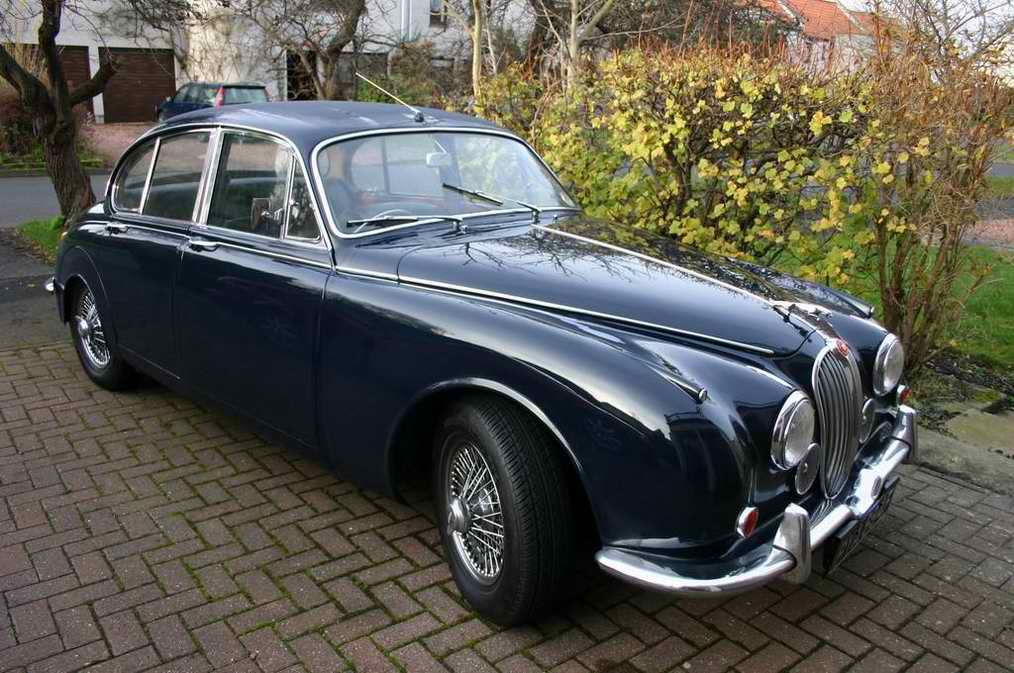
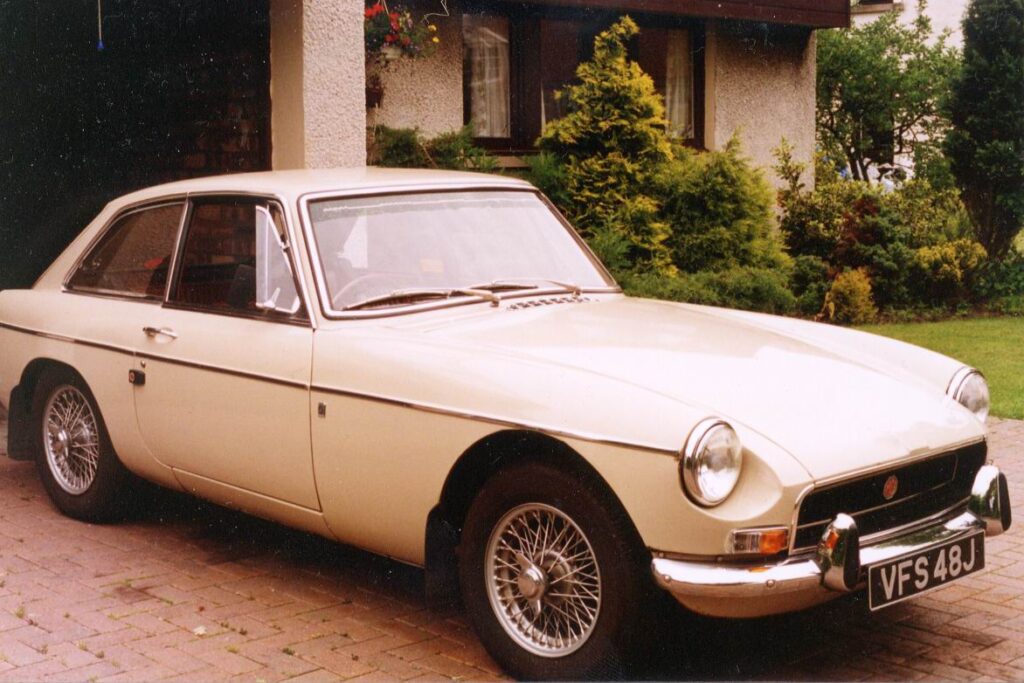
▸ As a trustee of the club, do you feel that Murrayfield TTC is in a healthy state? What does it need to do to ensure a healthy future?
▹ Yes, I do. The club has an excellent leader in Lindsay, and looking to the – hopefully distant – future we need to develop a potential successor(s). The Club’s finances are healthy enough, and I’m pleased that we’re not spending reserves but are continuing to seek funding and sponsorships because, with the important aim of our own premises, that is vital.
Activities to maintain the engagement of members, particularly during these restrictions, are good and it was good to see that there was no problem getting a quorum for the AGM.
Competitive success always helps and the Club is well placed in that respect with good players coming through being nurtured.
▸ Why do you think that table tennis has remained relatively minor sport in this country?
▹ I suspect there are a list of reasons:
• It needs quite a lot of space and equipment for a relatively small number of participants – particularly for competitive play. And hence is relatively expensive per player/hour – though I’d be interested in any comparisons that have been done on this.
• It does not appeal to a large number of spectators – it is a game for the players rather than the spectators. It does not appeal to spectators emotions in the same way as many sports; it expects quiet and careful attention.
• UK has never excelled internationally as a way of raising TT’s profile (though this observation is open to the criticism of “which comes first. . .” – c.f. China, and even Sweden.)
• How minor is TT? In East Lothian we discovered just how much latent potential there was once we started catering for it with satellite clubs in Musselburgh, Gullane, North Berwick and Dunbar. Not league play, but over-50s and social play and for disabled and schools.
• One of the reasons I’m pushing for TTS (and Clubs) to have a proper data base system is so we can register all the folk who are playing, not just league players, so we can see how minor, or not, TT is, and also have some more leverage with SportScotland as a less minor sport than they assume in terms of community funding.
Interview conducted by Charlie Ellis.
Many thanks to Roger for his participation.
